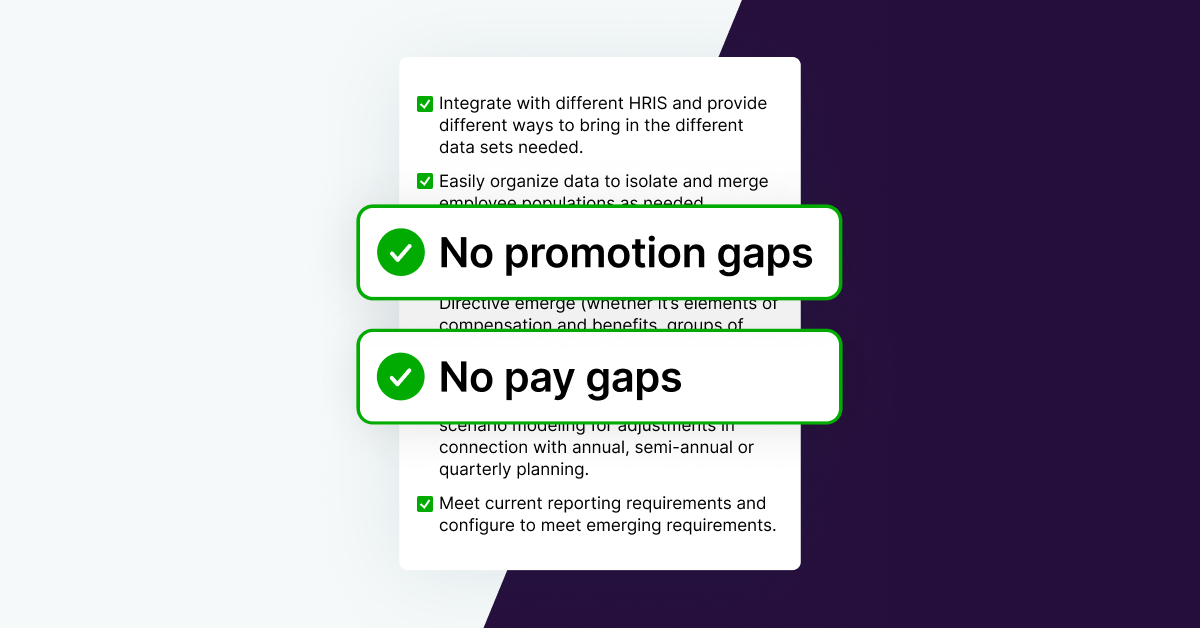If you’re on a Board of Directors, you’ve watched Environmental, Social, and Corporate Governance (ESG) start to dominate the conversation in the last year when it comes to investment strategies and analyzing business performance. To ensure accountability, CEOs are increasingly tying executive compensation to ESG performance.
According to executive compensation consulting firm Semler Brossy’s new ESG & Human Capital Management report, “These areas are not just nice-to-have or an expression of social responsibility; they’re existential. Companies are increasingly realizing that stronger human capital will help them improve the customer experience and respond to the vicissitudes of the marketplace.”
One driving factor in attracting and retaining that ‘stronger human capital’ is pay equity — equal pay for equal work. Below we share the top pay equity questions boards can ask their executive leadership to ensure progress.
Why boards should care about pay equity
New domestic and international pay equity legislation is raising the standards for compliance and pay transparency. High-profile lawsuits are wreaking havoc on name brands.
Employees are increasingly asking hard questions about whether they’re being paid fairly — and sourcing questionable data sources when they don’t receive clear answers from their organization.
Through this lens, pay equity may be viewed as a threat — something better tucked away than addressed and exposed. However, this couldn’t be farther from the truth. The more that pay equity lives in the shadows, the less control the company has over swiftly remediating and preventing pay disparities, and the less control they have over the public narrative about whether or not they’re a “fair pay” brand.
Leaving your company’s stance on pay equity up to unknowing Internet users and inaccurate job search sites almost ensures a skewed perception. Internally taking control of that narrative, starting with an equity audit, is vital to establishing yourself as a fair pay workplace.
As a board member, the onus is on you to drive, support, and shape longer-term initiatives that protect your investments — and that includes helping your companies shift pay equity from a liability to a competitive advantage.
Top pay equity questions
Here are 10 pay equity questions board members can ask of leadership to make sure they’re taking the right action.
- Did we conduct a pay equity analysis?
- Which stakeholders were involved in the process? Did we engage executives, HR, Compensation, Communications, and Legal to ensure the analysis is aligned to our ESG and human capital strategies?
- Was the analysis comprehensive? Did it include base, stock, and bonuses (or only base pay); gender, race, and ethnicity (or only gender); and did it cover all countries where we employ people?
- What were the results of the analysis? Were there any disparities by race, gender or ethnicity?
- What actions did we take? Did we remediate salaries? If so, what was the total cost?
- Did we uncover root causes such as biased pay policies, inequitable starting salaries, or other systemic issues?
- What is our communication strategy? Which stakeholders are we informing of our pay equity status and why?
- Related, how do we plan to proactively address employee questions and concerns? How are we preparing for new pay transparency standards — both legislative and cultural?
- How frequently do we plan to analyze pay equity? How can we efficiently move from once a year analysis (or less) to establishing an always-on view into our pay equity status?
- What is our long-term plan for incorporating equitable pay into our business practices? And what preventative actions are we taking to reduce or eliminate pay disparities in the future?
A risk or an opportunity? Depends on the actions you take
Pay inequity poses a risk. Pay equity also presents an opportunity — and a path to building trust with employees and other stakeholders.
In his recent letter to CEOs, Blackrock CEO Larry Fink issues a warning: “Companies ignore stakeholders at their peril — companies that do not earn this trust will find it harder and harder to attract customers and talent, especially as young people increasingly expect companies to reflect their values.”
Contact us at the link below to learn more about how you, your board members, and corporate leadership can create a proactive, always-on strategy to stay ahead of pay equity issues.
The information provided herein does not, and is not intended to, constitute legal advice. All information, content, and materials are provided for general informational purposes only. The links to third-party or government websites are offered for the convenience of the reader; Syndio is not responsible for the contents on linked pages.


